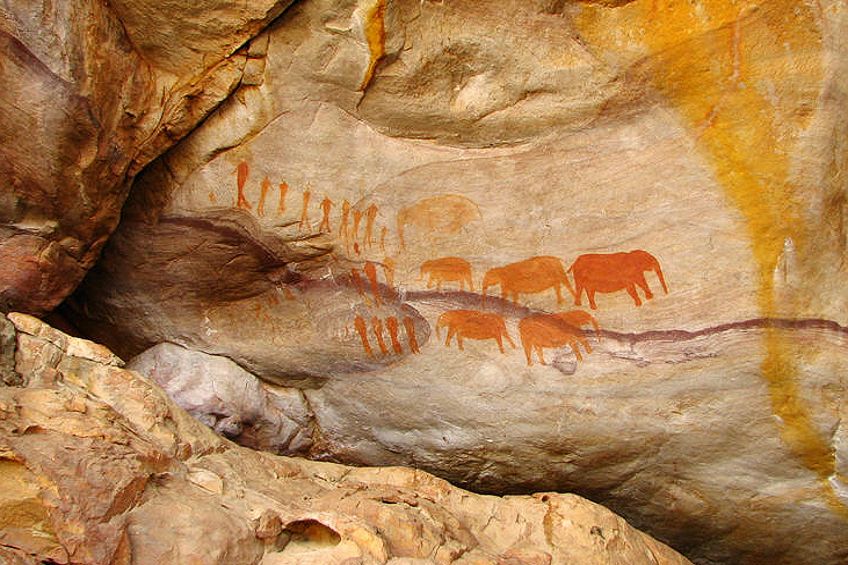African Art – Looking at the Development of African Artwork
The earliest appearance of African art is dated back to when humanity started walking the planet. Africa might be the birthplace of humankind, but it also currently has the youngest population in the world. A 2021 study showed that six in every ten people in Africa are under the age of 25! It is no wonder that this is one of the fastest developing regions on earth! Africa is also the most culturally diverse continent, with hundreds of different ethnicities and over 2000 different languages. Africa’s extensive art history has been under-documented throughout the centuries and its treasures are still hidden to many people all over the world. This article is merely a small introduction to the rich and vibrant history of African art.
What is African Art?
It is extremely difficult to provide any kind of overview or summary of African art characteristics. This is because Africa is a vast continent, diverse in both culture and religion. In fact, there is no single dominant culture in Africa. African art also spans centuries of dynamic development, ranges over many different materials, and serves many different purposes.
The variety of forms, practices, and influences include art forms used as entertainment, as centerpieces of ritual ceremony, for socio-political expression, for utilitarian purposes, or simply for decorative and aesthetic expression and value. There is thus no such thing as an underlying “African aesthetic” that can be used to define what African art is.
How Do We Understand African Art?
A lot of what we have learned and understood of African art thus far has been directed to us as a direct result of colonial expeditions and conquests in Africa. European colonizers took African artifacts from their homes and presented them in Europe as a kind of proof of what African art was.

In this process, they applied their own understanding of what was considered as “fine art” and what was considered as “craft”, and thus shaped the Western world’s idea of what African art is, based on their own definitions of art.
Misconceptions of African Art
African art can take on a wide variety of forms, from architecture to performance, to sculpture, textiles, pottery, metalwork, statuary, masks, and murals, to body paint and fashion, to name a few. The popular understanding of African art in the West, however, does not stretch much further to masks and figurative sculpture. This is because sculpture is something that fits neatly into the western definition of collectible fine art.
Most other forms of art in Africa were dubbed as mere craftwork. Below are some common misconceptions of what many people believe African art to be.
The Misconception of Painting in African Art History
For the longest time, it was believed that painting was not a pure art form in Africa. The reason for this belief is that African painting during the pre-colonial era was not on “collectible” objects like canvases, but rather on rock surfaces, walls of houses, and on human skin.
However, just because something cannot be placed on a plinth or hung on a wall, does not mean that it is not art.
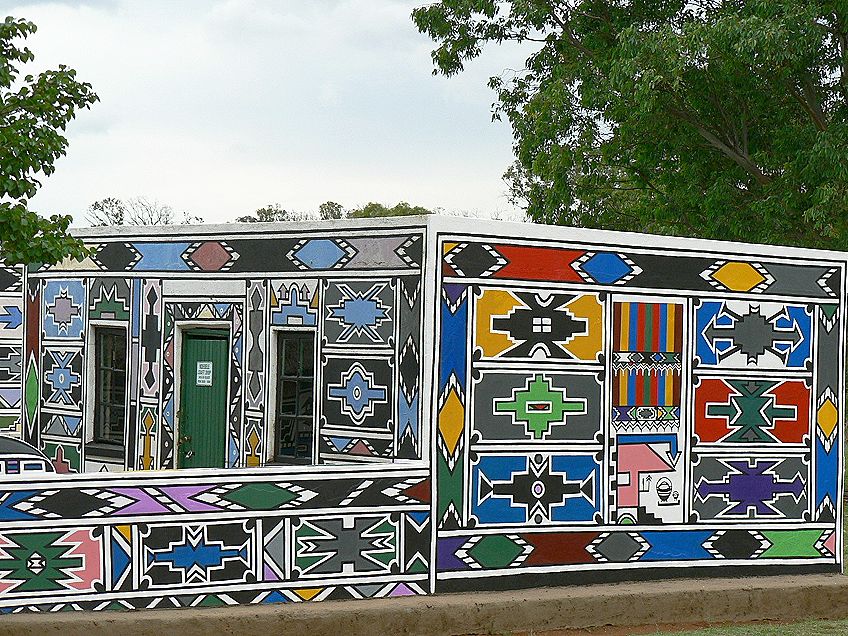
Africa’s definition and appreciation were different from that of Europe and includes so much more than the African artifacts that were collected by the West. An example of African paintings can be seen in the colorful patterned painted houses of the Ndebele people in South Africa.
The Misconception of Functional African Art
Another misconception about African art is that it is solely functional, whilst Western art is art for art’s sake, thus only created for the purpose of being art. The reality is that art is created for many different reasons, and the purpose of art is a complex question to answer, and this is true for Africa, as much as it is true for any other region of the world.
It is true that many African sculptures and artifacts were created with a certain purpose in mind, such as to be used as part of a ritual or ceremony, but this does not mean that the object was not simultaneously enjoyed simply for its aesthetic value.

An example of this is African musical instruments, which were not only used for music or ceremony but also appreciated as art. Instruments were often decorated and uniquely sculpted. An example is of this can be seen in the above image which shows a bowl lyre (Ndongo) instrument, made in the 19th century in Ghana.
The instrument has a remarkable sculptural quality and is made from wood, lizard skin, shells, and goat hair.
The Misconception of African Art as Constrained
Throughout history, there has been the assumption that Western art is something that is free to transform based on the artist’s wishes, and that this is somehow not true for African art. This is of course a misconception too.
Whilst there are traditions of repetition in some African art forms, there are also highly inventive forms found in pre-colonial Africa.

There are many traditions in Africa that encourage creativity, and this can be seen in, for example, Asante silk weaving in Ghana or Kuba cloth embroidery in the Congo. The image above is an example of a ceremonial Kuba cloth, designed to be used as an overskirt. The edges are ruffled and wavy to increase its aesthetic movement during dancing.
African Art Characteristics
The misconceptions and history of the acquisition of African art, make it difficult to give a true reflection of the general characteristics of African art. There are, however, a few general characteristics that can be discussed under what has been collected over time. Some of these characteristics include:
- The importance of sculpture.
- The innovation of form.
- Visual abstraction and the prevalence of assemblage.
- The occurrence of both balance and asymmetry.
- The human body as an art medium.
- The layered and diverse meaning of works.
- The importance of performance as artistic expression, which includes music, dance, fashion, sculpture, masks, and the decoration of the body.
African Sculpture
We often think of wooden masks and carved figures when we think of African art. Mediums for sculpture in Africa are, however, much more diverse and include metalwork, clay sculpture, pottery, bronze casting, copper works, stone carving, and ivory carving. The sections following will look at some examples of what was discovered in these mediums over millennia.
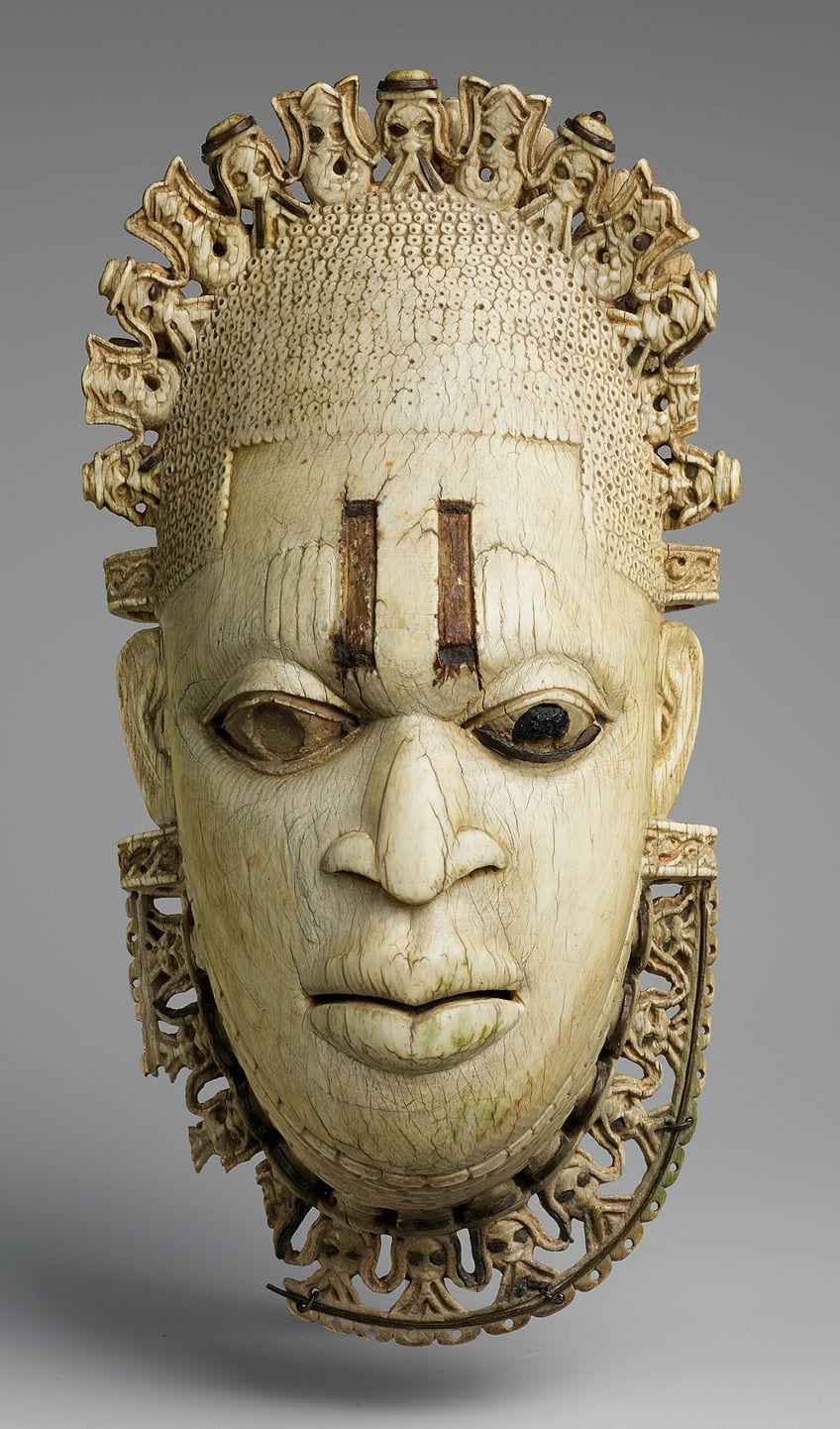
Clay Sculpture
Works from clay are probably the most widely used medium in African art, however, these have largely been omitted from history books because they were fragile and thus difficult to transport and collect. Figures out of fired clay were discovered by archeologists in areas such as Chad and Zimbabwe dating back as far as the early Middle Ages, the second half of 1st-millennium C.E.
Since these discoveries were made of fired clay sculptures, it signals that there must have been a rich history of unfired clay that was used for sculpture even before these were made.

An example of complex African fired clay sculptures is the Nok terracotta figures of Nigeria. These figures are the oldest known art to come out of Nigeria. The figures were found accidentally during mining operations in 1977. The image above is one of 153 Nok sculptures successfully removed from the mining site by archeologists. The sculptures were attributed to the Nok culture, whose civilization lived in this area from approximately 1500 BC until 500 CE.
The size of these terracotta works ranged from one inch to life-size, and while depictions of animals were naturalistic, depictions of humans were more abstract and stylized. The works were thus a form of artistic expression, and the maker clearly took their time to create these magnificent works.
It is believed that these sculptures were based on wooden models that were first created, but if there were any artifacts to be found to prove this, it is likely that they would have already disintegrated by now due to the high humidity of West Africa.
People from the Nok culture also made works from molten iron and their smelting furnaces are some of the oldest in the world. Sculpture made from molten and wrought iron would become an important influence in most West African artwork, including the Yoruba, Fon, Dogon, and Bambara people. The use of terracotta as a medium is however not restricted to West African artwork.
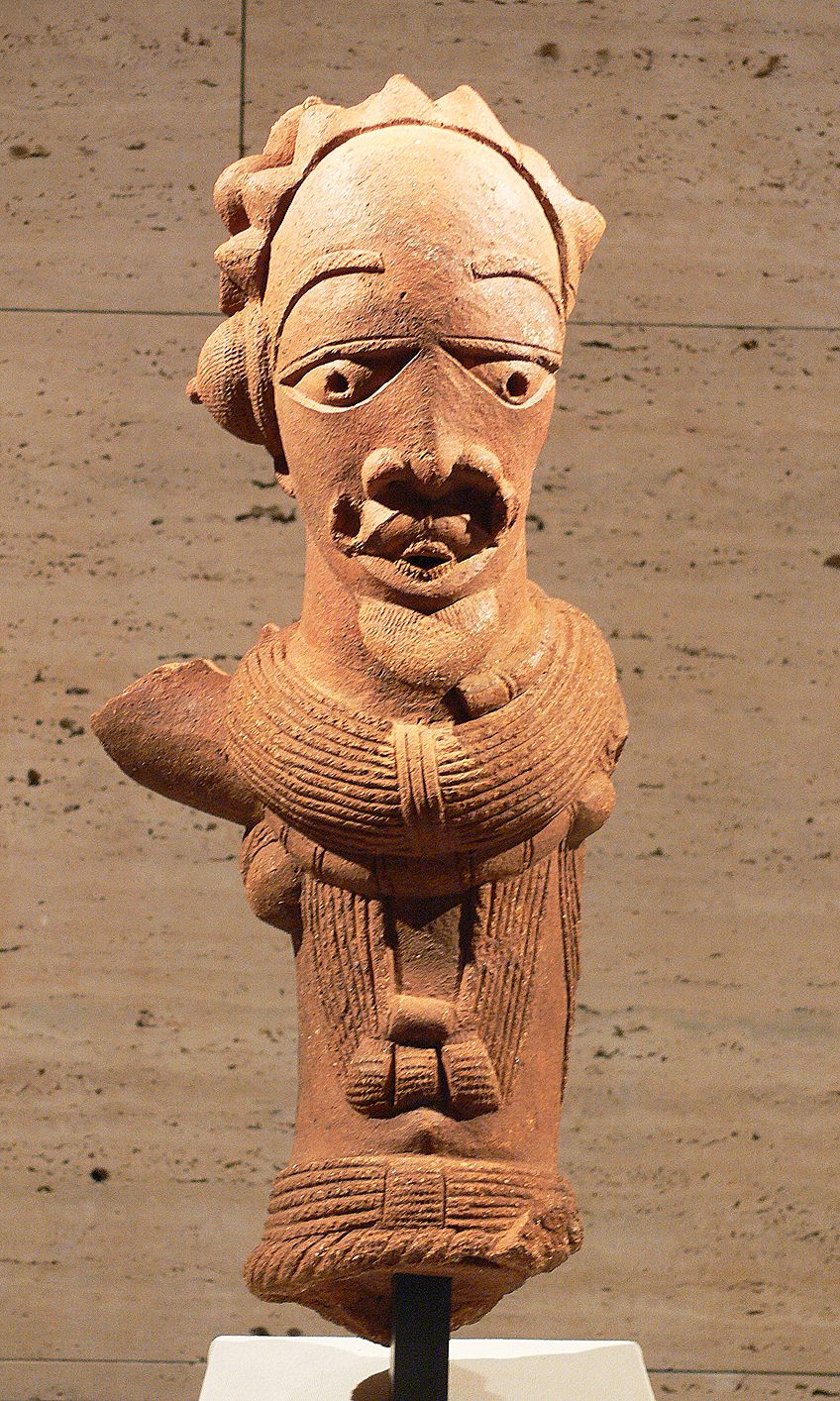
Examples of earthy terracotta sculptures were also found in South Africa, which were dated to be created during the same period as the Ife and Nok terracotta sculptures. An example of these works is the seven Lydenburg heads, found in Mpumalanga, South Africa. One of the heads was dated back as early as 500 CE. These works are more solid and stout compared to the more detailed Nok sculptures.
The Lydenburg heads are proud African artifacts and are claimed to be the oldest sculptural works of art discovered in Southern Africa.
Bronze Sculpture
Bronze castings that were found in Nigeria dated back to the 9th century CE. This involved a complicated process, the “lost wax” casting method, which is still used in many bronze and copper casting foundries today. The largest known collection of such works is from Benin, where they used copper-alloy zinc brasses.
These works are known as the famous Benin bronzes, although they were made from brass. The image below is a brass plaque from the Edo people in Benin. The work, dated to be made around the 16th to 17th century, illustrates warriors ready for battle.
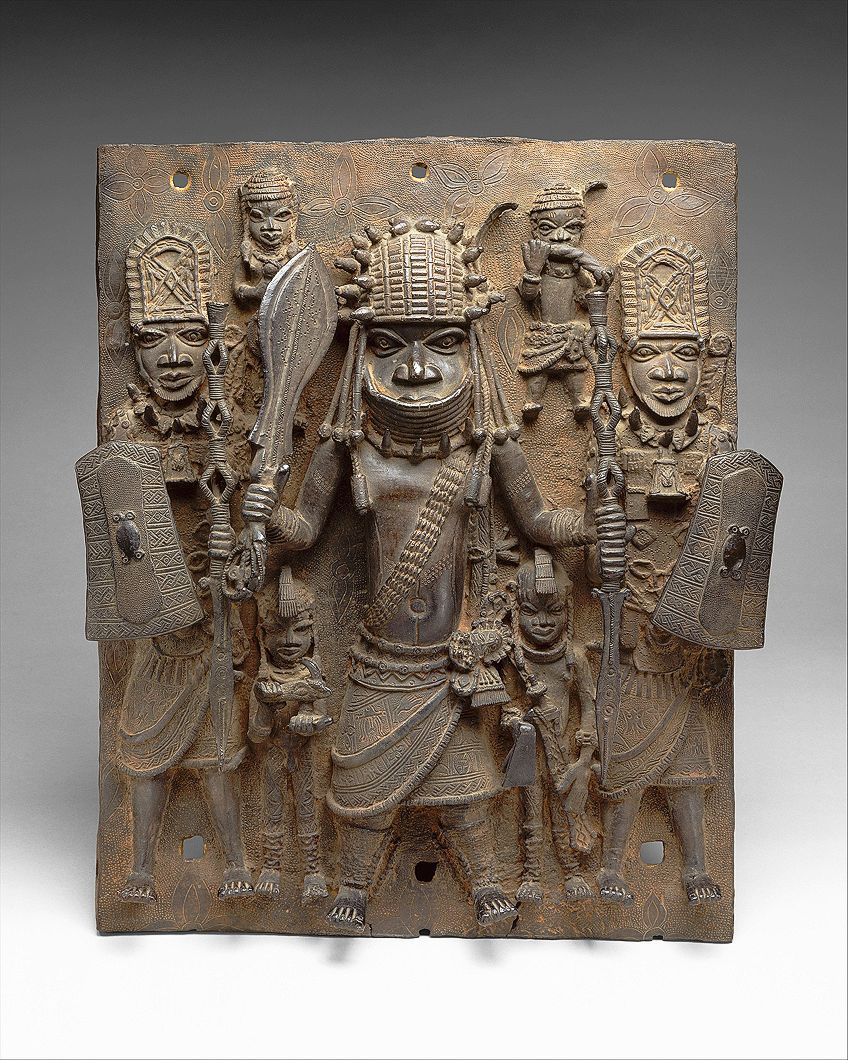
Benin is located close to where the Nok culture’s remains were found and are believed to be the successors to the Nok cultures. This means that they inherited the Nok culture’s collections of terracotta figures. The artists from Benin derived inspiration from these figures and became well known for their metalwork.
The famous Benin bronzes included various sculptures of heads, similar to the terracotta works of the Nok people, but they were mostly known for their brass plaques that depicted historical events, important people, or simply everyday life.
These panels were used to decorate the pillars of the royal palace of Benin. Sadly, most of these original plaques were taken from the royal palace in 1897 by British armed forces. Most of the Benin bronzes are housed today in British, German, and American museums.
Wood Sculpture
Apart from clay, wood is most likely the most popular material used in African sculpture. The extent of use is however very difficult to determine because as a natural material, wood decays over time. There are, however, still an incredible amount of well-preserved African wood sculptures that can be seen to this day.
Many of these sculptures are spiritual in nature and represent human forms or masks. Some also include animals.
Part of the reason that many wooden sculptures were not well preserved, is because they were never intended to be static artworks to sit on a plinth in a museum. These sculptures had ceremonial value and were passed on through generations, representing a living culture. An example of such a ritual object is the “Chiwara”. The Chiwara is a wooden sculpture that resembles an antelope, and it was used by the Bambara people of Mali.
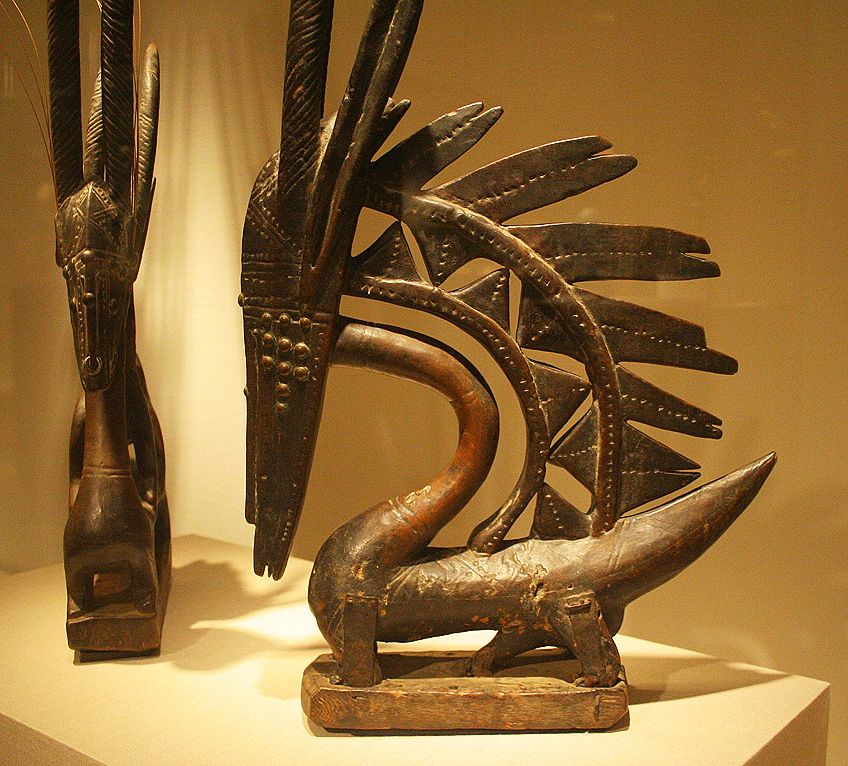
The Chiwara sculpture is seen as a mask as they are worn on top of the heads of dancers. They were used during dance and ceremonies in rituals that were specifically related to agriculture. The ceremony was aimed to teach the young Bamana men the importance of agriculture and social conduct.
The style of the Chiwara differs over generations and across regions and can be either male or female. The female Chiwara includes the figure of a baby antelope, while the male Chiwara has horns. The faces are long and slender and remind one of a human face.
Ivory Sculpture
African Ivory sculptures started developing in the late 15th century and are believed to be brought on by European influence into the Congo, Nigeria, and Sierra Leone. Ivory is seen as a very valuable item in Africa and its finer texture allows for fine and delicate carving.
The ivory sculpture is made from elephant tusks and is a fine bone-like material. Ivory tusks were often engraved with intricate scenes and events and these scenes can often tell us if the tusk was made for battle or for export.
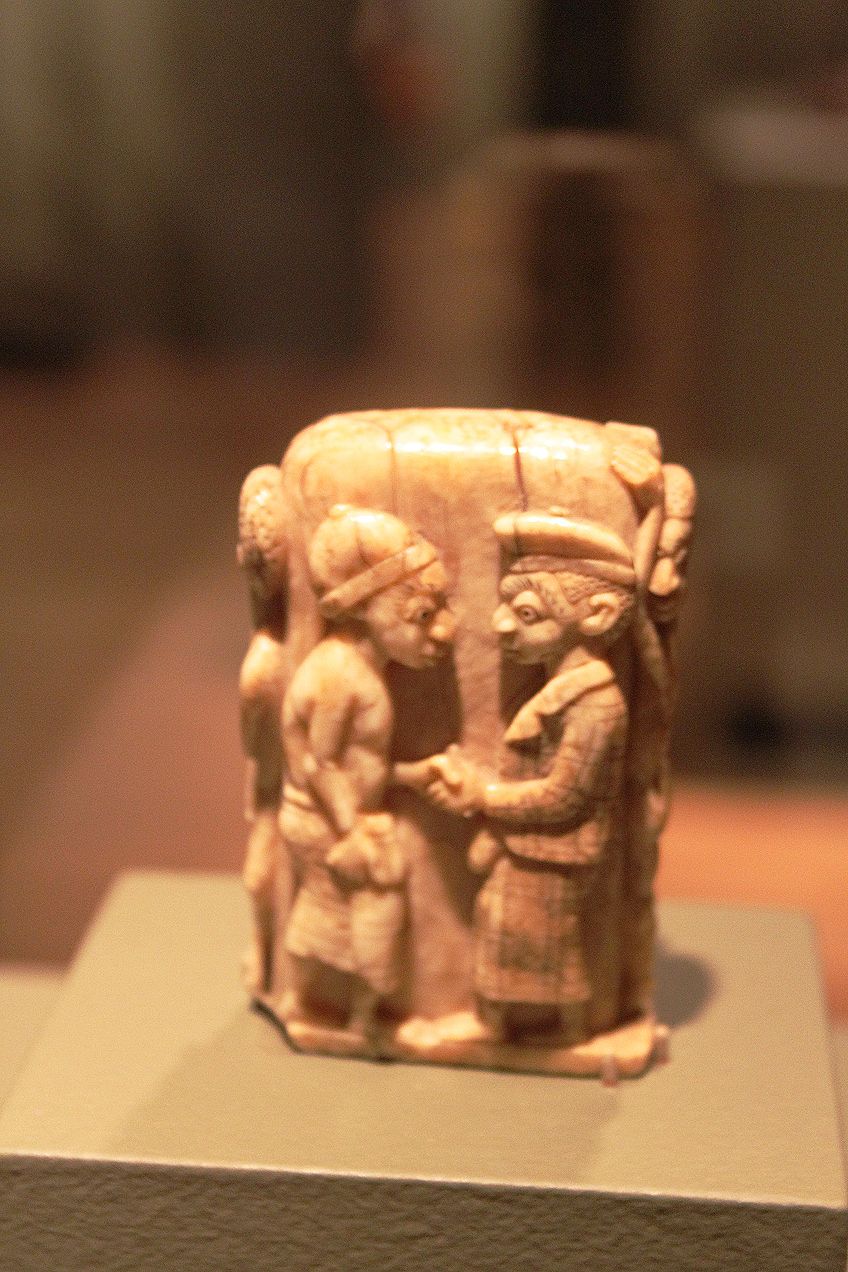
Ivory tusks made for battle were often engraved with scenes of hunting or battles and it was used as an instrument to signal danger to troops or hunters. These tusks belonged to the rulers and chiefs, and it was seen as dishonorable and embarrassing if the leader allowed the tusk to be taken during the battle.
Stone Sculpture
Stone sculpture with both hard rock and soft rock occurs in many different regions over the vast African continent. These however appear sporadic and don’t have as clear traceable development over periods of time, like with the wood, clay, or bronze works.
Some of the most incredible works of stone are however found when looking at ancient African art and architecture.
Ancient African Art and Architecture
The importance of human expression and creativity can even be found in the most ancient examples of African art and architecture. Below are a few examples of truly magnificent works of ancient African art. This is by no means an exhaustive list and to include all the remarkable works of ancient Africa, would result in many thousand-page books.
In this article, we will look at some examples from South Africa, Namibia, Egypt, Ethiopia, and Zimbabwe.
South Africa
About 300 kilometers east of Cape Town in South Africa, lies the Blombos Cave. In this cave, lies the proof of human occupancy that dated back nearly 100,000 years ago! Among the findings of archeologists were two carved pieces of stone, along with several beads made from seashells.
There was also evidence of two small rock art geometric patterned drawings, engraved into the stone in a deliberate manner with ochre. These drawings are claimed to be the oldest drawings ever to be done by the human hand.
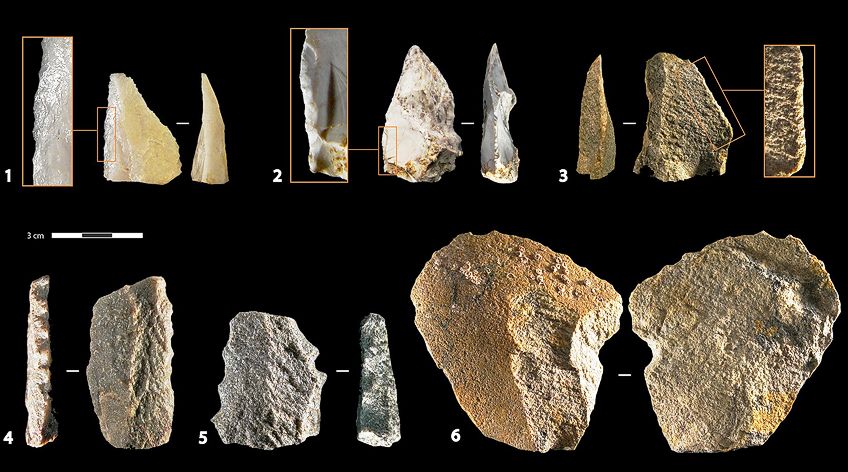
Namibia
In Namibia, a country bordering South Africa lies the Apollo 11 Cave, a rock shelter in the Namibian Huns Mountains. A significant discovery was found in the Apollo 11 Cave: some of the first examples of African paintings to be created on movable objects.
These paintings are also considered as one of the oldest examples of realistic art and included images of animals and insects. These images were created on hand-sized slabs of rock, using charcoal to draw and paint with. The paintings are estimated to be roughly 25,000 years old.
Egypt
It is impossible to speak about African art without including ancient Egyptian classical art. The first instances of Egyptian art date back all the way to the 6th millennium BC and span until the 4th century CE. Ancient Egyptian art includes various art forms, from rock drawings and ceramics to sculptures of stone and ivory, to drawing on papyrus, jewelry faience, and architecture.
There are many significant examples of the brilliance of the art of this ancient civilization, however, in this article, we will just touch on the incredible ornaments found in the tomb of Tutankhamun.
Tutankhamun (born c. 1342 BC), known as the “boy king”, passed away at the young age of about 19 and ruled Ancient Egypt for approximately ten years. While there wasn’t much of great significance that transpired during his rule, his tomb and the magnificent ornaments found inside it, made him famous in the history books. The ornaments are considered masterpieces of ancient Egypt and were placed in his tomb to accompany the young Pharaoh into the afterlife.

There were many fascinating objects in the boy king’s tomb, including a wooden container that is believed to have held a mummified duck, several boomerangs that were believed to be used to catch birds, a musical instrument called a sistrum, and a senet board, which was a popular game played for entertainment in ancient Egypt.
Other objects include a meticulously detailed wooden carved shield that is sent with the Pharaoh for protection. The wooden shield had many negative spaces carved into it, showing that it was not used for battle, but rather for ceremonies.
The shield depicts the Pharaoh as a sphinx, standing on top of his enemies. On top of the sphinx sits a falcon, which is believed to be Montu, the god of war.

There were also beautiful pieces of jewelry found in the tomb, including a piece of a scarab beetle. The beetle was made from lapis lazuli, a valuable stone with intense blue color. Another piece of elaborate jewelry found in the tomb is a large golden falcon to be worn on the chest.
The famous crook and flail were found inside of the mummy wrapping of the Pharaoh and are incredible pieces of art. These pieces were made of gold, silver, and colored glass. They were essential symbols of power and royalty in ancient Egypt.
Ethiopia
Ethiopia is home to some of the oldest and most impressive churches in the world. Among these are the incredible rock-hewn churches of Lalibela. One of these churches is the famous Saint George church.
The church of Saint George is an incredible structure that was carved out for over 600 years into the pink volcanic rock of the Ethiopian Lasta mountains.
The massive structures of these Ethiopian churches are masterpieces of religious art. The insides of these churches, covered with colorful murals and relief portraits of saints, are even further testament to the mastery of ancient Ethiopian art.
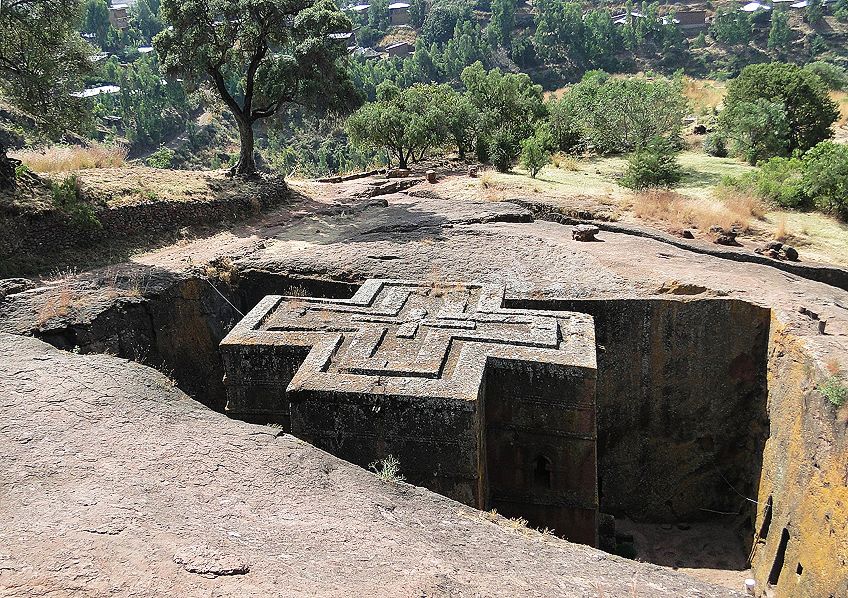
Great Zimbabwe
What was Great Zimbabwe, the capital of the Kingdom of Zimbabwe, is today mostly identified in ruins on the vast Zimbabwean plateaus. The ruins consist of complex and massive stone walls that were commonly referred to as the Great Enclosure. The construction of Great Zimbabwe, driven by the Bantu culture, expanded over 300 years, starting in the 11th century CE.
The Bantu people were known for their beautifully crafted jewelry, but little is left to see of this today. The city was destroyed in the 1890s when European colonists attacked its borders. Of the very little that remained of this great city, is a series of eight birds carved out of soapstone.
Archeologists are unsure what the purpose of the sculptures was, given the little context that is left to work with, but the birds became famous regardless. These birds are just under 40 centimeters in height and a representation of one of them is seen on the Zimbabwean flag.
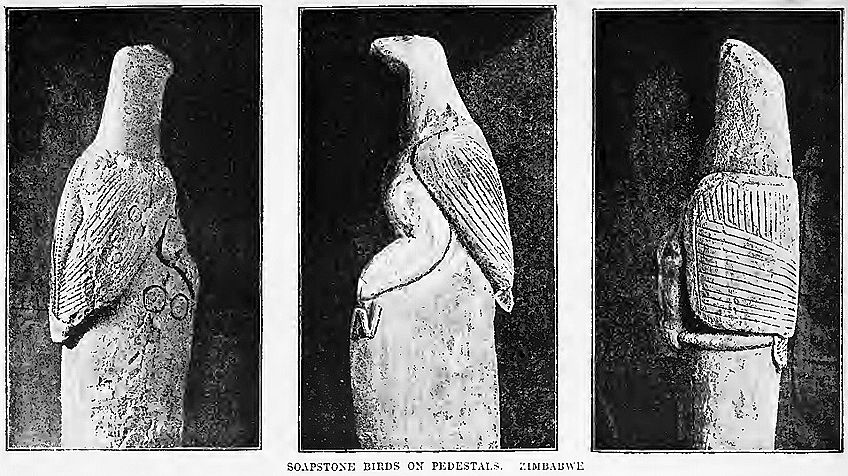
From Ancient to Contemporary
The incredibly high quality of modern and contemporary art that is being produced on the African continent today, has captured the eyes of the world. In Africa, art has never been static, and neither are African artists today. Curators and collectors have fixed their gaze firmly onto Africa, with the urgency, creativity, and dynamism of African artists keeping them captivated.
Contemporary African art cannot truly be classified as it is fluid and ever-evolving. When we speak of Contemporary African Artists, we generally speak of artists who grew up around the 1960s and later.
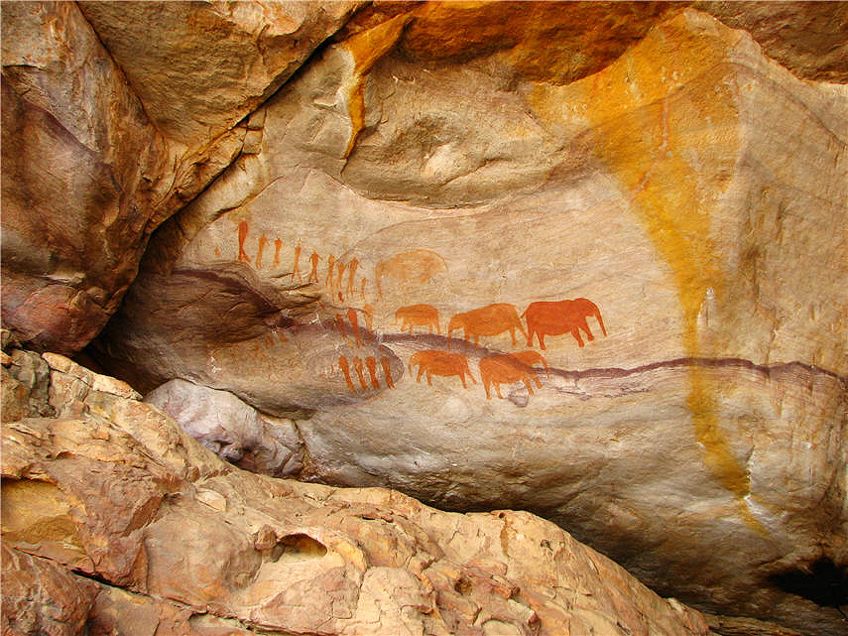
Contemporary art simply means the art of the contemporary (now) times and could generally include artworks created post-1970. In Africa, Artists growing up between the 1960s and 1980s, grew up during times of rapid change and development, and this is often reflected in theirs.
Many Contemporary African artworks could be classified as post-colonial and often draw from complex colonial pasts. Common themes that emerge include questions around national identity, displacement, economic disparity, the socio-political conditions of their environments, and more recent global discussions, such as gender and identity politics, and ecological concerns.

There are countless young contemporary African artists who are currently on the rise. Among these are artists like Sungi Mlengeya (born 1991, Tanzania), Gonçalo Mabunda (born 1975, Mozambique), Ayobola Kekere-Ekun (born 1993, Nigeria), Kelechi Charles Nwaneri (born 1994, Nigeria), Alida Rodrigues (born 1983, Angola), Moussa Traoré (born 1998, Mali), and Keyezua (born 1986, Angola).
The more established contemporary African artists includes Tracey Rose (born 1974, South Africa), Mechac Gaba (born 1961, Benin), Kudzanai Chiurai (born 1981, Zimbabwe), Sokari Douglas Camp (born 1958, Nigeria), El Anatsui (born 1944, Ghana), Aida Muluneh (born 1974, Ethiopia), and Pascale Marthine Tayou (born 1966, Cameroon).
Reading Recommendations
African Art is an incredibly broad and complex topic to discuss in one short article. We hope, however, that this article gives you a small peek into the wonders of African Art and that your hunger to know more about it, is only starting. Below are some of the books we recommend starting you on your journey of exploration of the expanse of African Art.
African Artists: From 1882 to Now (2021) by Phaidon Editors
This book is a sure one to dazzle and inspire. Phaidon Editors recently released an informative collection of some of the most exciting modern and contemporary African artists that produced important work from 1882 until 2021. The book features the work of more than 300 artists, including Julie Mehretu, El Anatsui, David Goldblatt, and Lubaina Himid.
- An A-Z survey of over 300 modern and contemporary African artists
- Stunning pictures of artworks that are paired with insightful texts
- Covers painting, sculpture, installation, photography, and performance art
Early Art and Architecture of Africa (2002) by Peter Garlake
This book covers over 5000 years of African Art. The book is focused on the diversity of African art and challenges the common misconception of African art. The book discusses the topic with a strong historical background and focuses on seven regions, namely Southern Africa, West Africa, Nubia, Aksum, Great Zimbabwe, and the East African Coast.
- Focuses on seven key regions within Africa
- Sets each region within their social and historical context
- Challenges centuries of misconceptions surrounding African art
African Art (World of Art) (2003) by Frank Willet
This book is a classical study on the diversity and variety of art on the African continent. Among others, it looks at the art of the BaTeke, the BaKota, and the Fang peoples. It considers the aesthetic impact of African art and the influence it had on the development of twentieth-century Western art.
- Excellent resource for students and anyone interested in African art
- Revised edition has been updated to include recent research
- Complete with 291 illustrations, with 88 being in color
Historically in Africa, art has differed from that known in the West, mostly because African art was something moving and dynamic, it was part of the culture and used in celebration and ceremony. This is different from the European ideal of art for art’s sake, that is that art is created as an object where its only purpose is to be art. This different view of what is considered art has affected the way the West has historically thought about African art. Today, however, we think about these things differently and realize that one region’s idea of art might change from another’s, and that art can be defined and recognized in many different forms. The art produced in Africa over millennia has been nothing short of dynamic and wonderful. Contemporary art from Africa is some of the most exciting and important in the world today, and the world is keeping its eyes fixed on the region to see what it might produce next.
Frequently Asked Questions
How Did African Art Influence Cubism?
Many Cubist paintings had a strong influence from traditional African art and these paintings had distinct mask-like features. Picasso is one artist famous for the heavy influence of the African aesthetic in his paintings. The African masks had an abstract quality to them and they were often highly stylized, whilst still being obviously human. This style, along with the earthy color palette of the masks, influenced Picasso greatly. While the Cubist movement might have been sparked by the works of Paul Cézanne, it is these African-inspired paintings of Picasso that truly made the movement what we know it to be today.
What is African Art Mostly Used For?
African art could have different utilitarian functions, or it can serve a social or political purpose. It also often has spiritual significance and is used in ceremonies or rituals. Certain African artworks are created for the pure purpose of their aesthetic value, whilst others are informative of current or historical events. African art can take many different forms that have a variety of different meanings or purposes. These meanings, forms, and purposes also change over time.
Why is African Art Abstract?
Not all African art is abstract and there are many examples of African artworks throughout history that were more naturalistic. It is true, however, that most African art is abstract. The root of this phenomenon lies within the need of African artists to use art as a tool for expression and innovation. In Africa, art is often used to express ideas and emotions, rather than simply representing a subject.
Jordan Anthony is a Cape Town-based film photographer, curator, and arts writer. She holds a Bachelor of Art in Fine Arts from the University of the Witwatersrand, Johannesburg, where she explored themes like healing, identity, dreams, and intuitive creation in her Contemporary art practice. Jordan has collaborated with various local art institutions, including the KZNSA Gallery in Durban, the Turbine Art Fair, and the Wits Art Museum. Her photography focuses on abstract color manipulations, portraiture, candid shots, and urban landscapes. She’s intrigued by philosophy, memory, and esotericism, drawing inspiration from Surrealism, Fluxus, and ancient civilizations, as well as childhood influences and found objects. Jordan is working for artfilemagazine since 2022 and writes blog posts about art history and photography.
Learn more about Jordan Anthony and about us.
Cite this Article
Jordan, Anthony, “African Art – Looking at the Development of African Artwork.” artfilemagazine – Your Online Art Source. February 3, 2022. URL: https://artfilemagazine.com/african-art/
Anthony, J. (2022, 3 February). African Art – Looking at the Development of African Artwork. artfilemagazine – Your Online Art Source. https://artfilemagazine.com/african-art/
Anthony, Jordan. “African Art – Looking at the Development of African Artwork.” artfilemagazine – Your Online Art Source, February 3, 2022. https://artfilemagazine.com/african-art/.


